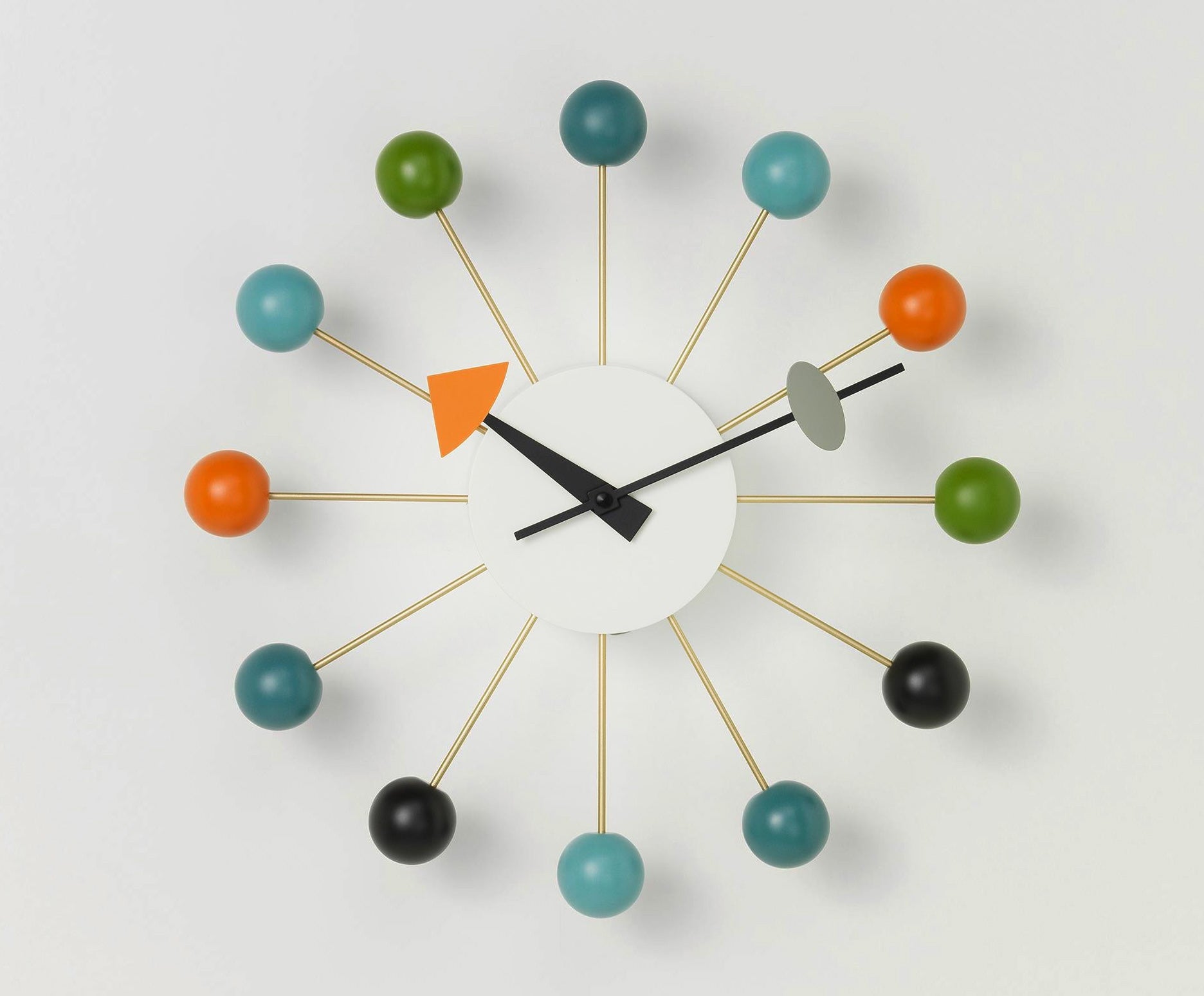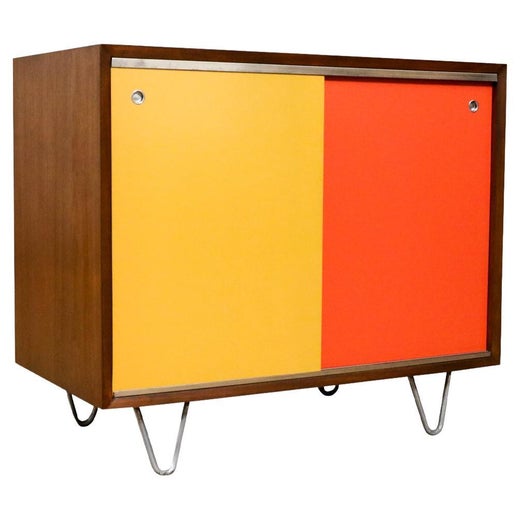Vitra Ball Clock in Red by George Nelson
About the Item
- Creator:George Nelson (Designer),Vitra (Manufacturer)
- Design:Ball ClockNelson Bubble Lamp Series
- Dimensions:Height: 13.01 in (33.02 cm)Diameter: 13.01 in (33.02 cm)
- Style:Modern (In the Style Of)
- Materials and Techniques:
- Place of Origin:
- Period:
- Date of Manufacture:Contemporary
- Production Type:New & Custom(Current Production)
- Estimated Production Time:10-11 weeks
- Condition:
- Seller Location:New York, NY
- Reference Number:Seller: 201250051stDibs: LU3989112382103
Ball Clock
The Ball clock — a starburst-shaped assemblage of lollipop-like brass spokes capped with lacquered birch orbs, playfully mismatched hands and absolutely no numerals — was the first of more than 150 clock models conceived in the New York City offices of legendary writer, architect and furniture maker George Nelson (1908–86). As Stanley Abercrombie reported in his 1994 book George Nelson: The Design of Modern Design, the first sketches of the oddly configured timepiece materialized one night in 1947, when a group of design luminaries worked their way through a roll of drafting paper as well as a number of cocktails.
Nelson was joined at his Manhattan studio by futurist architect Buckminster Fuller, sculptor Isamu Noguchi and a young designer named Irving Harper, who worked for Nelson and who is now credited with the Ball clock concept. “We were all involved in cooking up these clocks,” Nelson told Abercrombie of the event.
Two years later, in 1949, the Howard Miller Clock Company, once a division of Herman Miller — where Nelson was director of design for nearly three decades — introduced the Ball clock. With its high-grade quartz movement, curious color scheme and balance of geometric forms, the abstract design found its way into homes nationwide soon after it went to market. Nelson later remarked that the whimsical timepiece was ubiquitous, frequently appearing in advertisements set in a kitchen. And thanks to its resemblance to a ball-and-stick model of an atom, it came to symbolize the postwar Atomic Age. Today, the Ball clock is available in a variety of configurations from Vitra and is powered by a single AA battery.
George Nelson
Architect, designer, and writer George Nelson was a central figure in the mid-century American modernist design movement; and his thoughts influenced not only the furniture we live with, but also how we live.
Nelson came to design via journalism and literature. Upon receiving his bachelor’s degree in architecture from Yale in 1931, he won the Prix de Rome fellowship, and spent his time in Europe writing magazine articles that helped bring stateside recognition to Ludwig Mies van der Rohe, Gio Ponti, Le Corbusier and other canonical modernist architects.
In the 1940s, Nelson wrote texts that suggested such now-commonplace ideas as open-plan houses, storage walls and family rooms. D.J. De Pree, the owner of the furniture maker Herman Miller, was so impressed by Nelson that in 1944 — following the sudden death of Gilbert Rohde, who had introduced the firm to modern design in the 1930s — he invited Nelson to join the company as its design director. There Nelson’s curatorial design talents came to the fore.
To Herman Miller he brought such eminent creators as Charles and Ray Eames, Isamu Noguchi, and the textile and furniture designer Alexander Girard. Thanks to a clever contract, at the same time as he directed Herman Miller he formed a New York design company, George Nelson & Associates, that sold furniture designs to the Michigan firm. Nelson's studio also sold designs for clocks to the Howard Miller Clock Company, a manufacturer that was initially part of Herman Miller before it became an offshoot that was helmed by Howard Miller, D.J. De Pree's brother-in-law.
Nelson’s New York team of designers (who were rarely individually credited) would create such iconic pieces as the Marshmallow sofa, the Coconut chair, the Ball clock, the Bubble lamp series and the many cabinets and beds that comprise the sleek Thin-Edge line.
For dedicated collectors, as well as for interior designers who look beyond “the look,” there is a “cool factor” inherent to vintage pieces from George Nelson and others. Nelson was in on it from the start, and it’s valuable to have a piece that was there with him.
But still, as is evident from the offerings from dealers on 1stDibs, in any of the designs, in any iteration whose manufacture Nelson oversaw and encouraged, there are shining elements of lightness, elegance, sophistication — and a little bit of swagger. George Nelson felt confident in his ideas about design and didn’t mind letting the world know.
You May Also Like
Vintage 1950s American Mid-Century Modern Wall Clocks
Brass
Mid-20th Century American Mid-Century Modern Wall Clocks
Metal
Vintage 1950s American Mid-Century Modern Wall Clocks
Brass
Vintage 1950s American Mid-Century Modern Clocks
Wood
Vintage 1950s American Mid-Century Modern Table Clocks and Desk Clocks
Brass
Mid-20th Century American Mid-Century Modern Table Clocks and Desk Clocks
Brass
Vintage 1950s American Wall Clocks
Metal
Mid-20th Century American Mid-Century Modern Wall Clocks
Metal
Vintage 1950s American Mid-Century Modern Table Clocks and Desk Clocks
Metal, Brass
Vintage 1950s American Mid-Century Modern Table Clocks and Desk Clocks
Metal, Brass
Recently Viewed
View AllRead More
A Guide to Herman Miller’s Most Iconic Furniture
The prolific manufacturer has partnered with many of the world’s top designers since opening its doors in 1923. Here are some of the company’s greatest hits, which helped transform the American home and office.
Kule and Forsyth Give Iconic Furniture a Bold Makeover with Stripes
Maggie and Anne Genovese, of Forsyth, teamed up with fashion designer Nikki Kule to reimagine some classic pieces.

